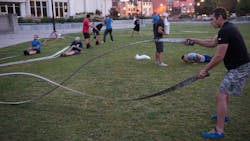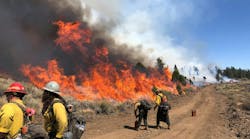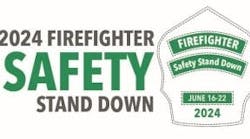Over the past 10 years, the fire service has taken increasing notice of the numerous health issues facing our industry. This is evident by the large number of articles and seminars that are now dedicated to promoting better health and fitness. But has this added focus on health and wellness made an impact? There are still far too many instances of injury, obesity, heart attack and cardiac arrest. Are we missing something? Are there some underlying factors or issues that are restricting better health within the industry? In an attempt to answer these questions, I consulted some influential voices to get their thoughts on the state of health and fitness within the fire service.
Meet the advisers
To get a good pulse on the industry, I sought out a diverse advisory panel that represented a wide range of experience, age and even geographic area.
The youngest interviewed is Josh Waldo, the fire chief in Bozeman, MT. Waldo has served in both career and volunteer departments during his 15-year career. He holds master’s and bachelor’s degrees from Eastern Kentucky University, and is a triple designee via the Center for Public Safety Excellence. He is one of the up-and-coming fire chiefs and has a very proactive approach to leadership.
Derek Alkonis—an assistant chief for the Los Angeles County Fire Department (LACoFD)—was an obvious choice for this article. Over his 27-year career, Alkonis has been instrumental in establishing the LACoFD as a leader in fireground safety and fire service wellness/fitness. A firm proponent of training, Alkonis has developed and implemented innovative programs supporting fireground tactics and firefighter survival and health. He is a member of the IAFF/IAFC Fire Service Joint Labor Management Wellness-Fitness Initiative (WFI) Technical Committee and UL’s Firefighter Safety Research Institute Advisory Board.
Culture plays a big role in how we approach health and fitness. No one understands the culture of the fire service better than Firehouse Contributing Editor Chief John Salka. A retired battalion chief with FDNY serving as commander of the 18th battalion in the Bronx, Salka has instructed at several FDNY training programs, including the department’s Probationary Firefighters School, Captain’s Management Program and Battalion Chief’s Command Course. He conducts training programs at national and local conferences and has been recognized for his firefighter survival course “Get Out Alive.”
I interviewed each chief about various health topics related to the fire service.
Chief Josh Waldo
Aaron Zamzow: As a new generation fire chief, what emphasis do you put on fitness and wellness in your department?
Waldo: It’s big to me! Some may not know this, but I used to be 60 pounds overweight. The added weight affected me both mentally and physically. I still remember the fire where I was inside, looking for any reason to leave, as I was just so out of shape, I couldn’t go anymore. That vivid memory helped me understand the value and importance of fitness and wellness. After that call, I made some drastic changes in my life and now make fitness a priority for me and for my department.
Zamzow: How important is it for the leadership in the fire service to set a positive example when it comes to health and fitness?
Waldo: Absolutely critical. Anyone who has been around the fire service for longer than five minutes knows that firefighters don’t respond to the, “Do as I say, not as I do” style of leadership. If leaders are simply talking the talk and not walking the walk, then their message is lost in translation. I hear a lot of chiefs talk about the lack of time to exercise or schedules that don’t allow for good eating habits, both of which I think are excuses. Nobody ever said maintaining a high level of fitness was easy. Preparing meals the night before, getting up early to get a workout in, or simply prioritizing your health as a fire service leader are things that have to happen if you are going to be successful. If a leader didn’t wear their PPE or seatbelt, how could they support policies or rules for their members to wear them? Same thing with fitness: If the leaders of the department aren’t willing to set the example, how can they expect members to follow. I’m not expecting all chiefs to be tri-athletes, but being 30-plus pounds overweight shouldn’t be acceptable either.
Zamzow: How can department leadership set the example?
Waldo: You don’t have to be a tri-athlete, but you must put in the time and effort. If you aren’t committing time to your own physical health and setting aside time for exercise, again, you’re sending the wrong message. Cardiac-related issues continue to lead the way when it comes to firefighter deaths each year, and the fire service continues to make bold statements about needing to address the problem, but provides light action on the back end. I have even seen departments that try to implement fitness requirements for line staff only to exempt chief officers, which is a major failure in my opinion. If leadership isn’t willing to commit to addressing their own physical fitness, then they have NO ability to require anything of their members.
Zamzow: What have you seen as the biggest challenge to promoting health and fitness?
Waldo: Buy-in and accountability. I think a lot of people are afraid of having a physical fitness program in their organization, especially if there is an accountability piece to it. If you were an NFL player and didn’t maintain your physical fitness to a certain standard, you wouldn’t play very long. Why is this not the same standard in the fire service? When our members are physically unable to perform some of the basic job tasks, the consequences are much higher than that of an NFL player. Cardiac-related issues lead the way in LODDs annually, and mandatory physicals and fit-for-duty standards are one way to address that problem. I believe we still have members and leaders who are afraid of both, as they fear it could force them out of the profession. Maintaining physical fitness throughout our profession is not easy and not something that will change overnight, but we didn’t get this way overnight either. Until we set a standard and FOLLOW IT, we are going to continue to struggle with members being fit for duty.
Chief Derek Alkonis
Zamzow: What is the main thing you do to stay fit?
Alkonis: I make the decision to wake up early, get out there and move! And then eat right so my body can perform and think clearly. Those are some of the principles I live with and have driven me to be active. I also have a family history of heart disease so that also motivates me to stay in shape. This also motivated me to study biology and discover how the body works. So my motivation isn’t totally altruistic toward the “fire mission”—not all geared toward performance but also toward longevity.
Zamzow: Heart attacks are still the number one reason we die in the line of duty. Why do you think we have not been able to decrease that statistic?
Alkonis: I think we just haven’t really made it a top priority. Why do we not achieve our goals in any portion of our personal lives? Because we haven't moved it up on the priority list. If it is that important, we need to strategize and focus on that important item. Now in contrast, we cannot beat ourselves up too much about making it a priority. Our biggest obligation is to those we serve, so the tendency is to focus more on them than ourselves. I do believe that there have been pulses of interest over the course of my career, which has been 27 years, where health and fitness were a focus, then it waned, and now we are coming back to it. I also think that we also must really understand and get data to know where our problem really is. If we had specific data to figure out who exactly is having the trouble and why they are, then we can address it. So maybe doing broad strokes is not good enough. We can put information out on the dangers and risks and ways to generally avoid it, but maybe there is a specific detail that we are missing, so we need to focus to really find more data.
Zamzow: Do you see a difference in how different regions approach fitness?
Alkonis: Yes, what we eat is influenced a lot by the geographical area in which we live. In Los Angeles, in most firehouses, you will get a healthy meal. They have introduced a lot of chicken breast and quinoa here. The culture on the West Coast is very active, so the diet and exercise in the fire service follow suit. Not to say that the West Coast is any better; it’s just different. Weather is a huge factor in fitness. It’s easy to exercise outside in weather like we have on the West Coast, so that helps with motivation.
Zamzow: What are we currently doing right to promote health and fitness? Where do we need to improve?
Alkonis: The IAFF, the IAFC and Firehouse have been very influential in pushing the health and fitness agenda. A lot of fire departments have wholeheartedly adopted the WFI since it came out in 1996. We have done a lot in the last 20 years for sure, but we also must show empirical evidence that we have made a difference. We have done a lot to quantify the fitness and health movement with NFPA 1582 and 1583, we have the WFI, and many departments have a fitness policy and have annual medical exam requirements and peer fitness trainers. So there has been a movement. In terms of where we need to go, we do need more data and need to improve on that. Departments need to hire healthy people and set goals that are centered on maintaining a healthy work environment. People are the fire service’s most valued resource so we need to focus on how to improve that resource. Then, we also need to hold ourselves more accountable to stay healthy and fit. Individually, we can hold ourselves accountable but perhaps the organizations should also.
Zamzow: What have you seen as the biggest challenge to promoting health and fitness?
Alkonis: The challenge is to hold each other accountable, but accountable for what is the challenge. This gets into the conversation of performance vs. criteria. The fire service needs to define how to determine whether someone is fit for duty. Not that administration needs to know, but the individual should and would want to know also. Then, if an individual is not up to standards, there needs to be resources in place to help them get there. But it goes back to how do we define and even quantify “fit for duty.” And to compound the challenge is that “fit for duty” can be defined differently based on location and department.
Chief John Salka
Zamzow: How does fitness play a role in firefighter survival?
Salka: The first issue here is that firefighters who are fit and healthy are much less likely to suffer a medical emergency, such as a heart attack or other cardiovascular event. This is obviously important because many firefighter LODDs are directly related to that issue. In plain English, if firefighters were not having heart attacks while on duty and while fighting fires, the number of LODDs would be down dramatically. And when those medical emergencies don’t happen at a fire, that means other firefighters don’t have to endanger themselves to go in and attempt to rescue the downed firefighter. So staying fit and healthy not only keeps you safer but it helps your brother and sister firefighters stay safe as well. Further, healthy and fit firefighters get to complete their careers or their volunteer service, live many years longer and enjoy retirement or family or second careers. The link between fitness and firefighter survival is gigantic!
Zamzow: You have said that looking back at your career, you would have spent more time with family and paid more attention to your health. Could you elaborate a little more on that?
Salka: As we all know or will discover, our time as firefighters passes quickly. It seems like just yesterday that I began my career with the FDNY. My 33-year career is over, and I have been retired for 5 years now. There is nothing I can do to change the past, meaning my past behaviors, eating habits and fitness regimen. I know people who have lost their families because they spent so much time and energy in the fire service. I know people who did not wear their PPE properly (or at all) for many years and were later diagnosed with lung cancer. I know firefighters who paid no attention to exercise or proper diet for decades and then had to struggle with serious medical problems into their retirement, rather than traveling and enjoying their grandchildren. If you haven't given these issues the proper attention over the years, you can’t do it over—but it’s not too late. I also know firefighters who were in terrible physical shape when they retired, but they turned over a new leaf and started working out and eating right. What are YOU going to do?
Zamzow: What advice do you have for the chief or veteran firefighter who does not think fitness is important?
Salka: Mainly just pointing out that firefighters live longer and happier lives when they are healthy. Who doesn’t want that? Also, if you want to get more job-related, you could ask them which firefighter will deliver better service to the public and their brother and sister firefighters: one who is fit and healthy or one who is overweight and struggling to put on an SCBA during a drill? The chief is the one who can elevate this issue from a discussion in the kitchen to a new policy of physical fitness for every firefighter. I remember many years ago when I was working as a career firefighter in Titusville, FL. The year was 1977–78 and guess what my crew did every shift? That's right, we worked out! I remember my lieutenant at one point, Bill Davis, in his red shorts and white department T-shirt, running us through the motions. That was almost 40 years ago. I guess the chief, Richard Cherry, was ahead of his time.
Zamzow: What are we currently doing right to promote health and fitness? Where do we need to improve?
Salka: Just the fact that we are writing and reading articles in Firehouse Magazine about these issues shows that there is an elevated awareness of the importance of fitness and wellness. We must continue to beat the drum and demonstrate how being fit is directly job-related. When firefighters start to consider their physical fitness as an element of their job readiness, we will have succeeded. Where do we need to improve? We should start allocating the same funding for physical fitness training and equipment as we do for forcible-entry simulators and flashover containers. Why do many departments have training periods every shift but no requirement for working out or staying fit? Why do we ignore a brother or sister firefighter’s declining physical condition until they cannot pass a physical to stay on the job?
Zamzow: What have you seen as the biggest challenge to promoting health and fitness in the fire service?
Salka: Lack of leadership! The American fire service has evolved into a highly educated and technically advanced workforce. We have more equipment, studies and programs than ever before, but most of us just pay lip service to fitness. How much attention is paid to fitness when a fire chief attends the Executive Fire Officer program at the National Fire Academy? How many of the hundreds of college degree programs designed for firefighters have a component focused on firefighter physical fitness? Why are there no 300-pound astronauts, Marines or lifeguards? Because their organizations have established standards for the fitness of their members so they can perform their duties. You see, it's not about us. It's about the people we are here to serve and the work that we must all be ready, willing and able to perform.
Final thoughts
The fire service has placed more focus on protecting our own, but we are still falling short. Before we start pointing fingers and calling out administration, we must first point out the obvious. The main priority of the fire service is to serve the people of our communities. This priority has taken priority for years and will continue to do so—but at what price? We need to prioritize our own health and fitness. Our advisors revealed some great views on the state of fitness in the fire service. Individually, we need to hold ourselves accountable.
Remember that, ultimately, the person you see in the mirror is the most responsible for your fitness. Departments and administration must lead the way by example and provide resources based on valid research. Further, we need to work on defining what it means to be “fit for duty.” With a consistent focus, we can make a positive impact on saving our own. And by saving ourselves, we will be better able to save those we serve.






